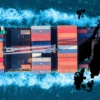In a year marked by rising inflation, global unrest and increasing demands for sustainability, fashion and lifestyle brands have never faced a more challenging operating environment. That’s why finding the best logistics solution for your business is critical to staying competitive. So, how can brands like yours prepare for an equally uncertain 2024? In this blog, we’ve compiled some of our top tips for overcoming the logistics hurdles that your brand may face.
Challenge #1: Inventory management
Maintaining the right level of inventory is one of the most difficult logistics issues to navigate. Stock too much of a slow-moving SKU and you’ll end up wasting valuable space. But stock too little of a product that becomes this month’s must-have and your website could soon be littered with out-of-stock banners – a great way to lose business to your competitors. So, do you risk sacrificing sales or prioritise consumer choice? It seems like an impossible balance to strike, especially in the fashion and lifestyle industry, which is built on seasonality.
And the problem of overstocking is growing. In fact, at the end of 2022, US retailers held a total of $740 billion1 in unsold inventory. This was largely due to retailers overbuying stock following the shortages experienced during the pandemic. Unfortunately, the demand-suppressing effects of inflation have meant that much of this inventory remained unsold. The impact of this huge surplus is twofold. It represents an economic loss to the brands that purchased the stock, and it represents an environmental loss due to the significant resources required to produce them. Of course, retailers always have the option of selling to discounters or donating the surplus items to charity. But from a business perspective, these solutions are far from ideal. So, how can brands avoid costly inventory miscalculations?
These days, there are a growing number of strategies that can help. One solution that’s becoming increasingly popular is dynamic demand forecasting. This innovative practice aims to accurately predict how much of a particular product retailers should buy. It does this by using an integrated technology network to connect players across the value chain – reducing the prevalence of the data ‘blind spots’ that can lead to over- and under-stocking.
How can dynamic demand forecasting prevent overstocking?
Take the example of Swedish fashion giant H&M, a pioneer of demand forecasting in the fashion industry. The company employs more than 200 data scientists to help predict the next big trend, and how much inventory the brand should therefore stock in its warehouses around the world. Using data analytics and artificial intelligence (AI), the company can think two or three seasons ahead and plan its buying decisions accordingly, making much more efficient use of warehouse space. This can lead to higher profit margins and less wasted clothing.
A basic example of the demand forecasting principle is the so-called lipstick index effect2. This economic theory states that when the economy is in decline, women will tend to buy more affordable luxury items, such as lipstick, rather than more expensive ones like handbags. During a recession, a department store using this principle to inform its purchasing decisions would stock up on high-end makeup items and buy fewer high-end luxury accessories.
Of course, H&M’s data analysis models are much more sophisticated, taking into account a wide range of cultural and socio-economic indicators. For example, its analysis includes live data from search engines, blogs and the H&M loyalty programme. The company also uses RFID tags to track the movement of products to and from stores and warehouses3, which can also be a valuable data point. Imagine how much you could learn about a product’s popularity by applying machine learning algorithms to an entire season’s worth of returns data!
As well as supporting a stronger bottom line, accurate demand forecasting also has important sustainability benefits. The more accurately you can predict what stock will be needed in the coming months, the fewer excess products will be produced in the first place – meaning fewer items will end up in landfill. Trend forecasting therefore plays a crucial role in H&M’s sustainability ambitions, including its commitment to net-zero emissions by 20404.
Challenge #2: Supply chain visibility
Another key trend that combines the topics of operational efficiency and sustainability is supply chain transparency. Establishing a transparent ‘chain of custody’ is key to ensuring a seamless customer experience and avoiding understocking. It allows better monitoring of inventory levels and makes it easier for consumers to track their purchases, thereby improving customer satisfaction5. However, achieving a high level of transparency can be complex.
The prevalence of offshoring in modern supply chains can make supply chain visibility a challenge. Some brands are addressing this issue by rethinking how they source products and raw materials. Practices such as ‘reshoring’, ‘nearshoring’ and ‘friendshoring’6 are becoming increasingly common in the fashion industry. Moving production closer to home makes it easier to guarantee good working conditions – reducing the potential for brand-damaging scandals. In addition, it makes quality control easier and allows for shorter lead times.
Meanwhile, by shortening the distance between the raw material producer and the end consumer, brands can reduce the potential impact of any unexpected supply chain disruptions. This helps to mitigate the effects of factors such as geopolitical tensions and customs delays. This strategy also helps to limit the distance that goods have to travel to reach the end consumer, resulting in a lower overall emissions intensity7 per item shipped.
There are signs that this sourcing trend is gaining momentum. Research from Gartner found that 30% of chief supply chain officers are already shifting their supply chain model from global to regional8. Meanwhile, 71% of chief procurement officers surveyed by McKinsey said they plan to increase the share of nearshoring in their sourcing mix9.
However, increased supply chain transparency requires close cooperation between the various parties in the fashion value chain. Modern technologies like blockchain can help. One high-profile example is the Aura Blockchain Consortium. This blockchain solution was launched by luxury groups LVMH, Prada Group and Richemont to improve traceability in the luxury sector. This helps both to reassure customers about the provenance of their products and to encourage more ethical and environmentally responsible sourcing practices.
Similarly, the textile fashion sustainability initiative Fashion for Good has partnered with BESTSELLER (owner of the Jack & Jones and Vero Moda brands) and Kering (owner of Gucci, Saint Laurent, and Balenciaga) to launch TextileGenesis™10. This blockchain-based traceability platform allows users to track the fibres that go into their products and verify that they come from renewable sources11. The platform is gaining traction in the industry. H&M Group now uses it to track hundreds of millions of items in its supply chain12.
Gearing up for the future of fashion logistics
As we’ve seen throughout this article, the biggest fashion and lifestyle brands are finding innovative ways to deliver higher levels of both convenience and sustainability. This can be a tricky balance to strike. But despite the many challenges facing fashion brands in an increasingly complex retail landscape, the changing context can also provide opportunities for your brand to stand out – if you know where to look. Perhaps it’s time to start rethinking your logistics strategy so you can ensure that shoppers will choose your brand over another in 2024.














